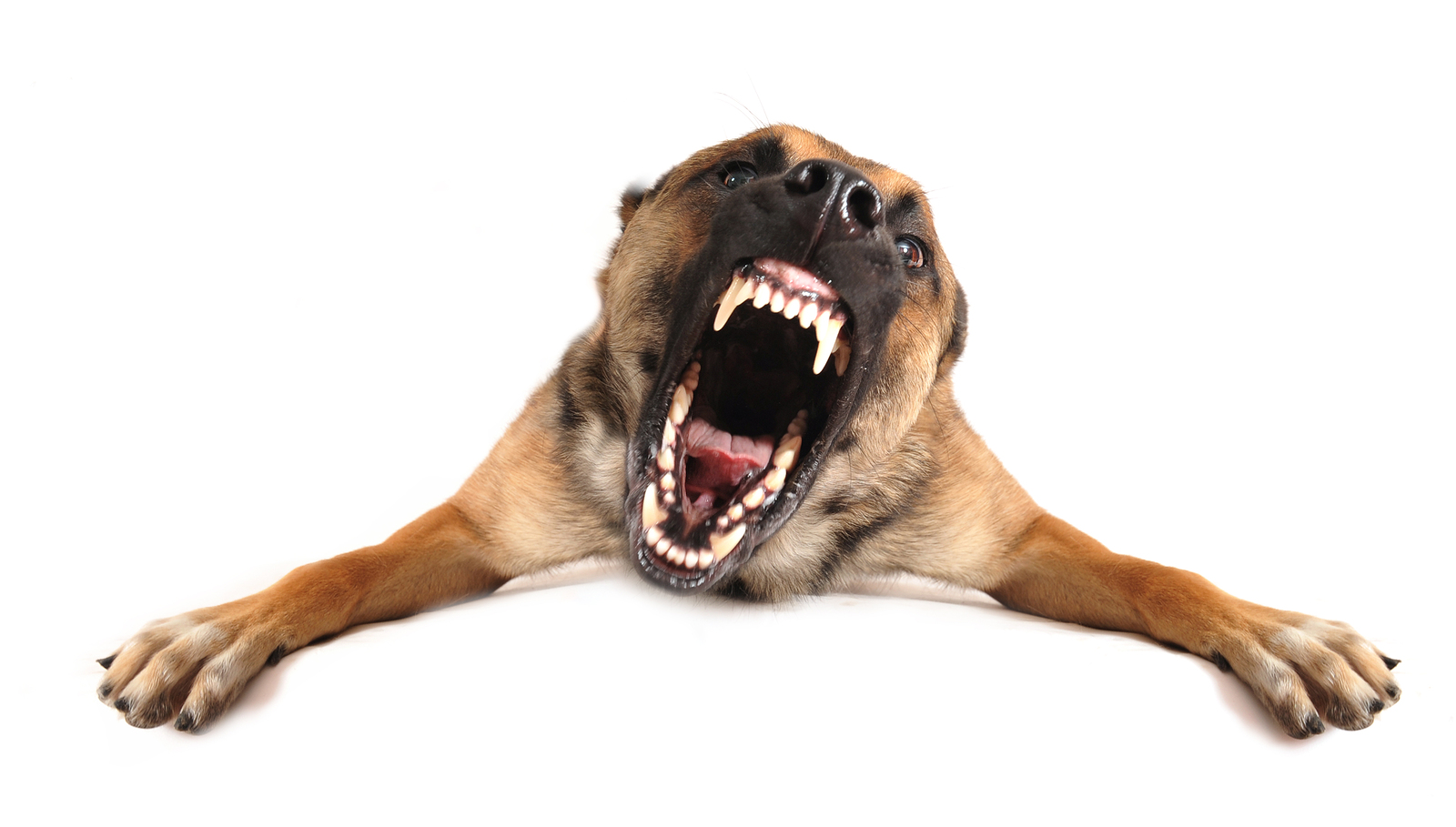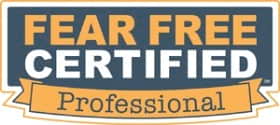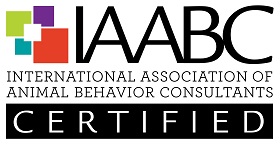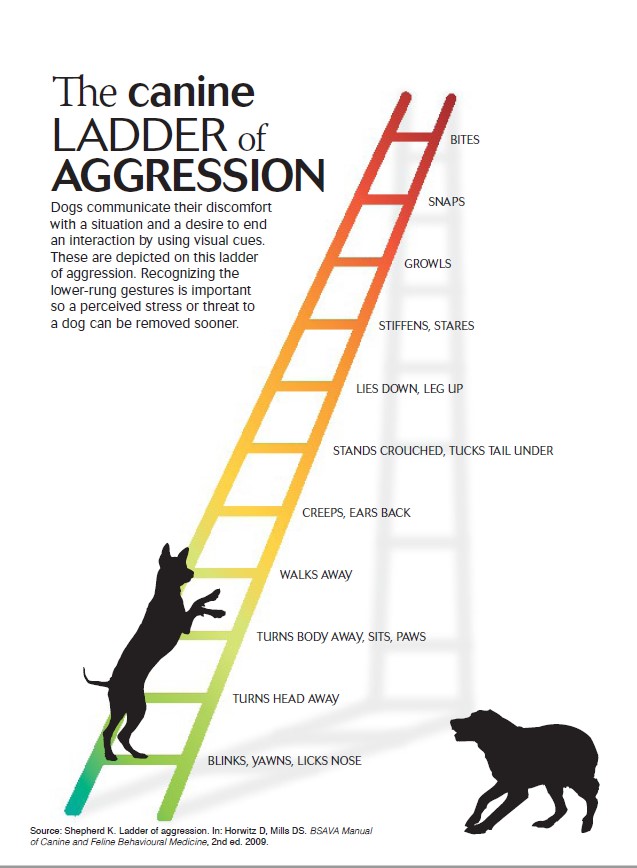Here are all of the dog aggression equipment, collars, harnesses and pet products that we recommend
What Is Dog Aggression?
Dog aggression is one of the most common dog behavior issues Russell addresses in his one-on-one custom dog aggression boot camp Los Angeles service where a Certified Behaviorist and Trainer works with your aggressive dog directly and intensely for longer periods while boarding and training.
Clinical dog aggression is defined as a dog behavior performed by a dog whose intentions are to injure another organism.
Dog aggression is somewhat of an arbitrary label since dogs don’t intrinsically have aggression inside of themselves (like a heart) but is an action associated with feelings. Dogs have a limbic system and a full range of feelings and emotions just as we do.
However, like in humans, aggression can be intrinsically reinforcing (self-reinforcing) if it alleviates fear anxiety, or stress.
Dog aggression is not a personality trait but a response to a stimulus in the environment. When a dog cannot increase his distance to a scary object or aversive stimulus the dog may become aggressive.
A common example is when the mailman comes and scares the dog. The dog then barks, growls, and lunges after the mailman, then the mailman goes away (increases distance). Therefore, the dog’s aggressive behavior continues to get reinforced.
In this example, when the mailman is removed from the dog’s threshold of fear, the dog stops displaying aggressive behavior. Hence this cycle strengthens the dog’s aggressive action and the dog’s behavior becomes conditioned, stronger, and learned. The dog is learning that when he acts aggressively by barking, growling, and lunging, the mailman increases his/her distance.
Aggression is a verb linked to emotion and chemicals. An ethologist, dog behaviorist, and dog aggression trainer will operationalize (scientifically measure) your dog’s behavior and provide a functional assessment. We describe behavior without predefined labels.
Dog aggression must be:
- Measurable
- Observable
- Objective
- Specific
For example, what’s more constructive, saying my dog is aggressive? Or the dog lunged three feet to the left and air snapped two times at an 8-year-old child and continued to lunge and growl while piloerected for one minute until the child walked away?
Descriptive actions are measurable and objective. Not merely labeling a dog’s behavior as “aggressive.”
The term aggressive is subjective and cannot be operationalized. Also “aggressive” means different things to different people. For example, most parents label their dogs as happy after the dog comes back from dog boarding or daycare even when the dog is fearful or stressed. On the other hand, many people label a dog as aggressive when a dog is simply playing with their dog toy or being social and playing with another dog.
However, for the sake of ease and convention, I will use the term aggression and aggressive in this article. However, if a Certified Behaviorist and Trainer comes to help train your aggressive dog, they will ask for operational behaviors that can be measured (dog growling, dog barking dog lunging, dog jumping, pinning down another dog, the dog is crouched down leaning back towards his hind legs with his tail between his legs and is piloerected, snarling with front teeth vertically exposed and commissures pulled back, etc.)
Check out our aggressive dog training in Los Angles, or Southern California area, or our phone and video consultations to get help with your aggressive dog from anywhere in the world!
Types Of Dog Aggression
There’s is no consensus amongst dog behaviorists regarding types of dog aggression labels. There is also overlap between many types of dog aggression.
The overwhelming majority of dog aggression comes from dog anxiety and fear. Dogs show anxiety and fear, primarily through their body language, but also through vocalization and biting.
- Defensive Aggression – Also correlated with Fear Aggression when a dog has anxiety about a situation, context, or stimulus and becomes protective.
- Dominance Aggression – Dominance aggression occurs when a dog challenges another dog’s social status or tries to control a resource or social engagement. Dominance aggression will often be seen in the dog park or be labeled as Play Aggression or Offensive Aggression. Dominance Aggression often occurs in overly bold and confident dogs.
- Fear Aggression – Also called Anxiety Aggression. Typically happens with less trained dogs who are also defensive and insecure, and shy dogs that display general anxiety.
- Frustration-Elicited Aggression – Also known as Redirected Aggression- Raise your hand if your dog has leash reactivity. Most dogs exhibit leash reactivity, for obvious reasons. Other Frustration Aggression causes are when a dog is trapped behind a fence, or baby gate. This may cause backyard fighting/fence fighting and barrier frustration. Frustration Aggression is very common and treatable.
- Idiopathic Aggression – When we don’t have a clue. Keller Breland and Marian Breland said it best with their article “The misbehavior of organisms.”
- Intraspecific Aggression – Also referred to as, Inter-Male, Inter-Female Aggression, and Dog-Dog Aggression. Intraspecific Aggression is sometimes linked to or labeled as Predatory Aggression. Dogs that usually exhibit Intraspecific Aggression are littermates. Siblings or dogs of the same breed, sex, size, and age experience intraspecific aggression and compete for the same resources.
- Possessive Aggression – Can also be called Territorial Aggression. This is often manifested in Resource Guarding. Possessive Aggression can occur with parent/s, toys, food, beds, sexual mates, territory/areas of the home, inanimate or animate objects, etc.
- Protective Aggression may involve people (family), territory, and maternal contexts. Protective Aggression is seen when a bitch has offspring in her den, whelping box, and also if a human parent is pregnant you might see a dog display Protective Aggression around the pregnant mother. Protective Aggression also occurs with territorial dogs around their home and property.
- Predatory Aggression – Predation aggression is when a dog preys on another animal. This may be displayed in a high prey-driven dog and is manifested by stalking, pouncing, hiding, hunting, biting, shaking, and killing behavior.
- Pain-Induced Aggression – Pain Aggression is typically associated with older age dogs. Dog’s with medical conditions also display Pain Aggression when they are in pain and are touched or handled in a way that used to be OK with them but now causes pain.
- Sexual Aggression – Also known as Mating Aggression. When a dog wants to mount or have sex with a bitch he may get aggressive. Also, a female in heat will send chemicals for miles that she is ready to reproduce and all dogs within her olfactory radius will pick up on her mating status. Male dogs may also become aggressive with each other to compete to mate with a bitch.
How To Tell If A Dog Is Aggressive?
Since I have worked with hundreds of aggressive dogs, I am often asked, “Do I have an aggressive dog?” and “What are signs that a dog is aggressive?”
I teach clients how to read a dog’s body language and emotion. If we can’t read a dog’s body language very well, we can’t receive vital information a canine is communicating to us. In particular, analyzing a dog’s anxiety and fear levels can serve as a preventative warning system for a person to take action to prevent a dog from becoming aggressive.
Body language signals that typically come before dog aggression are:
- Lip licking, yawning, excess blinking
- Whale eye (sclera showing)
- Hyper Vigilance
- Distance increasing behavior
- Hiding
- Cowering
- Ears back or flattened
- Tucked tail
- High erect, stiff tail
- Teeth baring
- Growling and lip curling
- Snapping
- Lunging
- Stiffening or staring
Important caveat – Dogs often display these warning behaviors prior to a bite. However, dogs don’t always show a nice linear progression up the ladder of aggression but jump directly to a dog bite. These dogs have a very low threshold for reactivity and low resiliency to fear aversion and novelty. This type of maladaptive dog may show very few signs of fear before upregulate and bite someone and are prime candidates for psychopharmaceuticals.
Causes Of Dog Aggression
Most dog aggression stems from fear and anxiety, not dominance. Just like aggression, dominance in dogs is not a personality trait inside a dog. Dominance is defined as priority access to preferred resources established by force. It is a relationship between individuals that requires aggression and submission.
Dog-person dominance (heterospecific dominance) is moot since people hold all of the resources and without us, our dog would die. Dog-dog dominance (conspecific dominance) does occur and is situational, treatable, and manageable.
Myth busters:
According to science dogs are not pack animals, wolves, alphas, betas or any other Greek letter, or carnivores!
Now that that’s out of the way… Some of the reasons why dog’s become aggressive are because their needs are not being met in some way. Make sure your dog’s Five Freedoms are cared for.
- Freedom from hunger or thirst
- Freedom from discomfort
- Freedom from pain, injury or disease
- Freedom to express normal behavior
- Freedom from fear and distress
Why Is My Dog Aggressive?
When a dog is anxious or afraid, they have three choices, Fight, Flight, or Freeze. They will choose what has worked in the past to create distance to whatever stimulus is causing fear, anxiety, or stress.
An impulsive dog that has not learned to self-soothe and self-regulate becomes impulsive and reactive. These easily startled, less resilient dogs become less confident in their environment and feel less safe.
Other Factors Of Dog Aggression
- Environment – Altering a dog’s environment is one of the most important ways to treat dog aggression. Your dog might have learned to be aggressive with dog training through learned behaviors and conditioning or fending for themselves via dog daycare and dog boarding environments. The situation context and what happened directly before and after a dog’s aggression are vital to figuring out the causes of a dog’s aggression. The environment in which aggression is occurring plays an integral role in why a dog is aggressive. Situational context includes social setting, dogs, pets, animals, people, novelty, unfamiliar events, things, lighting, temperature, somatosensory considerations, etc.
- Genetic Disposition – Neurochemistry, phenotype, and genotype all contribute to dog aggression. Breeding influence with regards to traits, temperament, and personality play a role as well as social style. For example, more mouthy dogs may be more prone to aggression. It is important to note that ANY breed of dog can be selectively bred to have certain traits and characteristics. Historically some breeds were bred to fight other dogs and animals. Luckily those numbers are very low now and any ethical breeder that has a dog that is predisposed to dog-dog aggression or dog-human aggression would immediately castrate that dog and the dog would not be a candidate to procreate. Although all dogs are individuals, some aggressive dog breeds are more likely to bite other dogs, strangers, and/or parents.
- Medical Physiological Function – A dog’s biology and constitution can cause dog aggression. If a dog is in pain, for any reason, they may feel more vulnerable. This can be the case whether the pain/discomfort is related to age, such as dementia, canine cognitive dysfunction (CCD,) or in general pain or discomfort because of arthritis, tooth cavity, gum disease, hip dysplasia, etc., these medical factors may all cause a dog to become aggressive as an expression of a dog’s pain.
- Emotions – Dogs need to feel safe, loved, secure, and cared for to function. A fearful dog needs dog training to learn independence and self-regulation. We need to provide an environment for a dog to build the chemical connectors to be able to process and modulate fear, anxiety, and stress. If a dog is too aroused this may cause aggression or a redirection bite. We need to also consider somatosensory considerations and hormonal fluctuations.
- Ethological Function – A dog behaves to survive. A dog will react to stimuli in the environment in many ways. A dog’s hardwired biological and survival function and ethological context predict a dog’s behavior to stay alive.
Dog Aggression Treatment
First, we need to tell what the root cause of a dog’s aggression is before we can formulate a treatment plan. For example, a fear aggression treatment plan would look radically different than a predatory aggressive dog or pain-induced aggressive dog treatment plan. Remember there is no regulation in the dog training and behavior industry so make sure to understand this before going to a dog aggression “expert.”
Another common example would be if intraspecific dog aggression presents itself in your home. A solution may be to alter one of the dogs and not the other. Spay/neutering one of the same-sex dogs would help change the chemical makeup and likely help with conspecific dog aggression in combination with SD/CC (systematic desensitization and counterconditioning) and obedience training, exercise, play, enrichment, socialization, and many other treatments listed below.
It is best to see an expert Certified Dog Behaviorist who specializes in dog aggression. Dog aggression can have serious consequences from legal and financial ramifications to euthanization.
All dogs bite and will react aggressively to a stimulus if they have no other options. Every dog needs management, but dogs who have a bite history or a history of aggression, especially need active management. Management procedures are part of a behavior modification protocol and are essential and vital protocols to ensure a dog’s safety and public health. If a parent does not have excellent management skills, an aggressive dog’s training prognosis is not optimistic.
Because each dog is unique and each situation different, it would be impossible to give a broad one-size-fits-all dog aggression training and behavior modification solution. Dog aggression treatment involves many hours of detailed analysis, learning about your dog’s ontogeny, environment, family, history, triggers, coping style, etc.
In many cases of dog aggression, anxiolytic medication is important. Especially for fear and anxiety-related aggression in conjunction with management and behavior modification techniques. Medication is often most useful for severe anxiety and phobic dogs, generalized dog anxiety, impulsive dogs that have little control, and high physiologically aroused dogs.
It is imperative to never use pain, or punitive training devices to try to treat or cure dog aggression. Never use choke chains, shock collars (aka vibration collars), or prong collars as they will make your dog’s aggression worse and cause more harm. For more information on why punitive dog training equipment is harmful to dogs please refer to this article.
Instead, a behaviorist may use any of these training methods and factors to treat an aggressive dog.
- Behavior modification – SD/CC when treating an aggressive dog. relaxation and deference protocols
- Foundation dog training skills – This will include marker training, station training, dog obedience training skills such as sit, down, stay, orienting toward to parent, and hand targeting
- Changing environmental aspects (including parents behavior)
- Medical health checkup – Including proper nutrition, supplements, and medications to help a dog succeed in learning new behaviors, decreasing impulsivity, and modulating their chemical reactions and emotions.
- Enrichment needs – Meeting the dog’s enrichment needs without allowing your dog to practice aggressive behavior. Do not stress your dog or put any person or animal in danger to meet your dog’s enrichment requirements (exercise, diet, socialization, play, toys, training, novel experiences, emotion, etc.)
- Management procedures – Strict adherence to management procedures is vital for any parent to follow meticulously to safely help an aggressive dog. Active management and compliance of the pet parent are mandatory.
- Aggressive dog training equipment – Use appropriate dog training equipment to train an aggressive dog such as head halters, muzzles, and harnesses.
Setting up the treatment plan and environment is critical to ensure everyone’s safety. Do not let your dog rehearse aggressive behavior. It is imperative to hire a dog trainer to help you analyze and change the environment so that your dog does not continue to be triggered by the scary stimulus and to set your dog up for success.
What Isn’t Dog Aggression?
Dog behavior doesn’t happen in a vacuum. The following behaviors typically do not mean your dog is aggressive, but in some contexts, may.
- Dog Humping Mounting
- Dog Barking
- Dog Playing/Roughhousing
- Dog Chasing
- Dog Jumping
- Puppy Play Bite
- Mouthing/Snapping/Nipping
- Making contact with teeth
- Separation Anxiety behavior
Dog Bites
What and who determines a dog bite? Is it based on contact with a person’s skin, damage to a person/ animal, or a dog’s intent? These are not easy questions and there are no universal answers.
Dog bite scales are often used in dog bite court cases but are subjective and flawed. Under certain definitions, anytime a dog touches their teeth to the skin of a person or another animal it could be considered a dog bite depending on how someone defines a dog bite.
With regards to an aggressive dog who bites it would best to seek out a dog bite and dog training expert.
Aggressive Dog Training Near Me Experts
Do you have an aggressive dog? Dog aggression is complex and requires an aggressive dog training expert with years of theoretical and practical experience treating and training a diverse population of dogs.
See how we can help you with your aggressive dog. We are experts in dog aggression training. Fun Paw Care specializes in dog aggression cases and has been successfully helping parents with their aggressive dogs for decades! Whether you live in Greater Los Angeles California or live around the world, fill out this short form for an expert Certified Dog Behaviorist and Trainer to help you with your dog’s aggression and training today.






